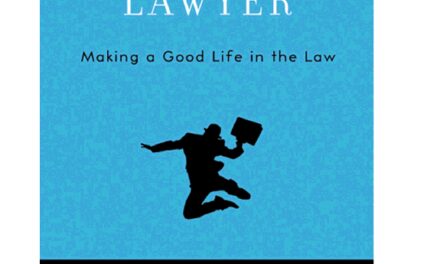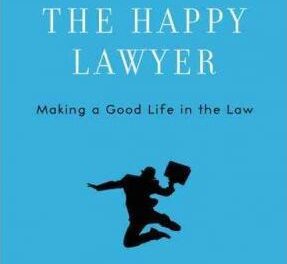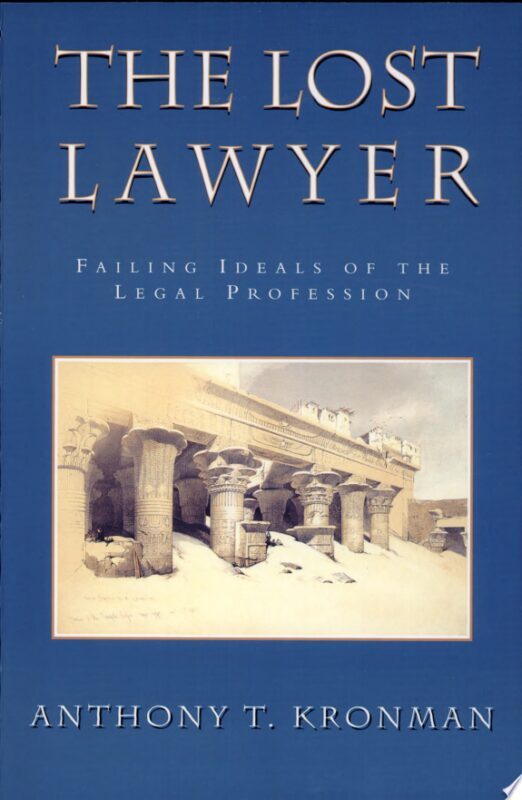Michael Sean Quinn, Ph.D, J.D., Etc.
2630 Exposition Blvd #115
Austin, Texas 78703
(o) 512-296-2594
(c) 512-656-0503
Preface
There are lots of books and articles focusing on a whole array of “happiness topics”:
- how to think about being happy or happier,
- how to become happy (ier), be happy(ier), stay happy, become more happy beginning from at the point of already being quite happy,
- how to conceive of, or grasp the image of, an aim for the happiest of all conditions,so on, and on, and on.
Not surprisingly, a number of these “[phony] treatises” or more likely “glossy mag” contributions have the making of money in mind. They are usually not genuine wisdom.
It should come as no surprise that none of these really focus on the problems of lawyers, however, and–“God knows,” say the authors–“for the most part, they [the lawyers] need it or, at least, could use it. If only they would pay enought attention. But, oh, not that lot.”
In 2010, a couple of law professors wrote a book with part of the above title, The Happy Lawyer (Oxford University Press). They taught at my law school, University of Missouri at Kansas City, though I never knew at least one of them. Their project was to indicate how lawyers may think and behave to obtain more happiness than they have. They are not aiming at the general populations or specific groups other than lawyers.
They are not trying to sell some specific, guaranteed, wild-ass-therapy, or even Dr. Phil. They probably even agree that some lawyers can also be not only be persons who are in wretched shape for reasons entirely independent of being lawyers. In fact a person’s being a lawyer might even mitigate his low rating on a “happiness scale.”
The themes and content of this book
are extremely important for any lawyer trying to analyze his/her life as a
lawyer and make it better from a personal point of view. Of course this is not the only place to find them formulated in different and/or more diverse terms, i.e., for more types of people. Whether the book is
right or wrong and/or involve important quandaries are also important questions–and in Part Five I will argue that at its foundations the authors have made at least one significant mistake–part of the empirical evidence is helpful and the recommendations, advice, or suggestions make it a consciousness raising piece of work
are extremely important for any lawyer trying to analyze his/her life as a
lawyer and make it better from a personal point of view. Of course this is not the only place to find them formulated in different and/or more diverse terms, i.e., for more types of people. Whether the book is
right or wrong and/or involve important quandaries are also important questions–and in Part Five I will argue that at its foundations the authors have made at least one significant mistake–part of the empirical evidence is helpful and the recommendations, advice, or suggestions make it a consciousness raising piece of work
I. An Introduction: Part One
Now, let us begin again. The authors are
trying to provide various types of information to lawyers about
themselves. In addition, and this is the central point of the book, they
are trying to give advice and make recommendations regarding how at least some
lawyers and some law firms can make themselves happier. Some of the empirical points in he book come from
systematic and objective empirical or allegedly such, mostly “university-based,” some of their personal
observations, some from others, and so forth. Some
of the claimed empirically based information comes from the new “sciences” of body, brain, an behavior experimental research.
trying to provide various types of information to lawyers about
themselves. In addition, and this is the central point of the book, they
are trying to give advice and make recommendations regarding how at least some
lawyers and some law firms can make themselves happier. Some of the empirical points in he book come from
systematic and objective empirical or allegedly such, mostly “university-based,” some of their personal
observations, some from others, and so forth. Some
of the claimed empirically based information comes from the new “sciences” of body, brain, an behavior experimental research.
The book is
about lawyers and law firms. It is about the mild and severe negatives in the
lives of lawyers–he kind hat make them unhappy, And it about how recommendations and advice how to overcome at least some of hem. This series of blogs has three dimensions.
about lawyers and law firms. It is about the mild and severe negatives in the
lives of lawyers–he kind hat make them unhappy, And it about how recommendations and advice how to overcome at least some of hem. This series of blogs has three dimensions.
The first describes some of he empirical evidence. Some of that is summary and some is critique. That part of the book focuses on some
sciences–physical and social. I will mostly discuss conclusions of some of the social studies; I will not discuss the physical. I don’t see it helping lawyers (or anyone deal, in practical ways with problems of unhappiness in he here and now–interesting those observations and methods are now and may be fore the far distance future. (Then again these studies may suggest helpful drug prescriptions, but that topic s not really discussed.)
sciences–physical and social. I will mostly discuss conclusions of some of the social studies; I will not discuss the physical. I don’t see it helping lawyers (or anyone deal, in practical ways with problems of unhappiness in he here and now–interesting those observations and methods are now and may be fore the far distance future. (Then again these studies may suggest helpful drug prescriptions, but that topic s not really discussed.)
Second, buried
in all of their work is some philosophy. The philosophy is significant.
in all of their work is some philosophy. The philosophy is significant.
The second
dimension is a set of empirical facts oriented to lawyers. None of the
“facts” are, “Precisely this happened,” or “Happens
all the time,” or, “Will uniformly happen.” Instead, they are about the
usual, the frequent, the statistical, and the important tendencies.
dimension is a set of empirical facts oriented to lawyers. None of the
“facts” are, “Precisely this happened,” or “Happens
all the time,” or, “Will uniformly happen.” Instead, they are about the
usual, the frequent, the statistical, and the important tendencies.
Third, there is
the advice given. Much of it is for lawyers and some for law firms. Much of it is
derivative upon the empirical. “Here is what you should do to be happier, given the evidence there is.”
“Find ways to overcome or separate yourself from the usual strings of events that hurt, etc.” Along with this,
there are tables or charts suggesting how one might move him/her self along the
way.
the advice given. Much of it is for lawyers and some for law firms. Much of it is
derivative upon the empirical. “Here is what you should do to be happier, given the evidence there is.”
“Find ways to overcome or separate yourself from the usual strings of events that hurt, etc.” Along with this,
there are tables or charts suggesting how one might move him/her self along the
way.
In this blog, the reader is in Part
One right now. Part Two discusses some of the empirical conclusions presented. Part Three focuses on their
directives and advice for lawyers. Part Four discusses advice for law
firms. (There is little to no empirical “back up” for the discussion of firms. Still, it hard to imagine that some of the images and advice would not be helpful.)
One right now. Part Two discusses some of the empirical conclusions presented. Part Three focuses on their
directives and advice for lawyers. Part Four discusses advice for law
firms. (There is little to no empirical “back up” for the discussion of firms. Still, it hard to imagine that some of the images and advice would not be helpful.)
Many parts of these discussions will be brief summaries attempted by me, and I will comment on some of them. I try to separate the statements of the authors from comments of mine.
Part Five will be a discussion of what I take to be some theories underlying the book. That is mostly me talking about them, their assumptions and inclinations. Some remarks of mine about various points will be included in all the discussions, here and there.
As already indicated, I will be
commenting on some of the authors’ theses and outlooks; however, this blog, even when taken as a whole, is not
intended to be a book review. It is intended to participate in an extraordinarily important discussion.
commenting on some of the authors’ theses and outlooks; however, this blog, even when taken as a whole, is not
intended to be a book review. It is intended to participate in an extraordinarily important discussion.
Here is an example that may confuse the two intentions: the book has several of what I will call tables or charts with various
normative questions, hints, and theses. Most of these are questions those who try and use the chart are to ask themselves. This is an extremely important part of the
book. As a recommendation of
“ways out” of, for example, depression, or for example, as routs to–at least more–happiness, the charts
fail. They might even be thought of as dangerous. They are, however, interesting topics for educational devices. No one should try to apply them in self-improvement situations; self understanding leading decisions for improvement frequently fails; cannot it cannot done and trying to do itcould easily lead to self inflicted harm. “If I cannot do this, I guess I am really as worthless as I often feel about myself.”
normative questions, hints, and theses. Most of these are questions those who try and use the chart are to ask themselves. This is an extremely important part of the
book. As a recommendation of
“ways out” of, for example, depression, or for example, as routs to–at least more–happiness, the charts
fail. They might even be thought of as dangerous. They are, however, interesting topics for educational devices. No one should try to apply them in self-improvement situations; self understanding leading decisions for improvement frequently fails; cannot it cannot done and trying to do itcould easily lead to self inflicted harm. “If I cannot do this, I guess I am really as worthless as I often feel about myself.”
Many of the
author’s most important theses are implicit. I plan to ignore the difference
between the implicit and explicit. Of course, I might be quite wrong. What I claim are implicit theses or arguments may not be either at all.
author’s most important theses are implicit. I plan to ignore the difference
between the implicit and explicit. Of course, I might be quite wrong. What I claim are implicit theses or arguments may not be either at all.
We now turn to the next chapter of this particular blog-series. Insurance lawyers might call the next section “Causes of Loss.” Come to think of it, so might litigation lawyers.







Recent Comments